Helen Sedwick's Blog, page 7
October 4, 2013
Lesson Plan: The American Dream in COYOTE WINDS
I want to thank Jessica Brown for writing a brilliant lesson plan on how the American Dream is explored in my novel, COYOTE WINDS. Below is the beginning of the plan. If you would like to see more, please email me at helen@helensedwick.com.
Coyote Winds Lesson Plan: American Dreams Subject: Literature/American Studies; Grade Level: 6-9 Duration: Three to four class periods
Writing in 1931, historian James Truslow Adams described the American Dream as “that dream of a land in which life should be better and richer and fuller for everyone, with opportunity for each according to ability or achievement.” He identified the American West, a place where “the frontiersman had developed the right combination of qualities to conquer the wilderness,” as the birthplace of this distinctly American can-do spirit. The American West, with its seemingly limitless land and boundless opportunities to start anew, seemed the perfect place for men and women to prove themselves, build their fortunes and live their dreams.
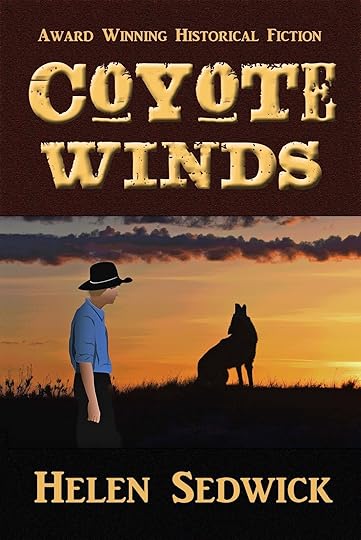 In this lesson, students will explore the theme of the American Dream and how it relates to the American West in Coyote Winds. After discussing their own interpretations of the American Dream and watching a brief video that defines the concept, students will break into groups and discuss how various characters’ dreams reflect, or fail to reflect, the American Dream.
In this lesson, students will explore the theme of the American Dream and how it relates to the American West in Coyote Winds. After discussing their own interpretations of the American Dream and watching a brief video that defines the concept, students will break into groups and discuss how various characters’ dreams reflect, or fail to reflect, the American Dream.
Guiding Questions: What is the American Dream? Is it different now than it was in the 1930’s? Is Coyote Winds critical of the American Dream or does it celebrate it? Might it do both? In Coyote Winds, how is the American Dream connected to the American West? Why do some characters see the prairie as a land of possibilities while others feel trapped in it?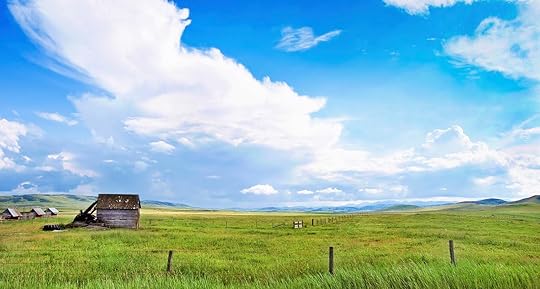 Objectives: In this lesson students will learn to: · Examine critically the concept of the American Dream.· Analyze a recurring theme in a literary text.· Conduct in-depth character analyses.· Use and summarize evidence from a literary text to support an argument.
Objectives: In this lesson students will learn to: · Examine critically the concept of the American Dream.· Analyze a recurring theme in a literary text.· Conduct in-depth character analyses.· Use and summarize evidence from a literary text to support an argument.
Procedure: Class 1: Introduction to the American Dream 1. Begin by asking the class to spend 10-15 minutes writing about what they think of when they hear the term “American Dream.” How would they define it? Do they know, or have they heard of people, who are living the American Dream? Is the American Dream distinctly American? Why or why not? After 10-15 minutes, ask students to discuss what they wrote with the class.
2. For common ground, have students watch this video on the American Dream: ** Throughout this activity, as keywords come up, have one or two students write these words on the board. Keep these words visible throughout the duration of the lesson.
Use the rest of the class to discuss how the American Dream is revealed in Coyote Winds, and especially how Lionel’s character embodies it.

Coyote Winds Lesson Plan: American Dreams Subject: Literature/American Studies; Grade Level: 6-9 Duration: Three to four class periods
Writing in 1931, historian James Truslow Adams described the American Dream as “that dream of a land in which life should be better and richer and fuller for everyone, with opportunity for each according to ability or achievement.” He identified the American West, a place where “the frontiersman had developed the right combination of qualities to conquer the wilderness,” as the birthplace of this distinctly American can-do spirit. The American West, with its seemingly limitless land and boundless opportunities to start anew, seemed the perfect place for men and women to prove themselves, build their fortunes and live their dreams.
 In this lesson, students will explore the theme of the American Dream and how it relates to the American West in Coyote Winds. After discussing their own interpretations of the American Dream and watching a brief video that defines the concept, students will break into groups and discuss how various characters’ dreams reflect, or fail to reflect, the American Dream.
In this lesson, students will explore the theme of the American Dream and how it relates to the American West in Coyote Winds. After discussing their own interpretations of the American Dream and watching a brief video that defines the concept, students will break into groups and discuss how various characters’ dreams reflect, or fail to reflect, the American Dream. Guiding Questions: What is the American Dream? Is it different now than it was in the 1930’s? Is Coyote Winds critical of the American Dream or does it celebrate it? Might it do both? In Coyote Winds, how is the American Dream connected to the American West? Why do some characters see the prairie as a land of possibilities while others feel trapped in it?
 Objectives: In this lesson students will learn to: · Examine critically the concept of the American Dream.· Analyze a recurring theme in a literary text.· Conduct in-depth character analyses.· Use and summarize evidence from a literary text to support an argument.
Objectives: In this lesson students will learn to: · Examine critically the concept of the American Dream.· Analyze a recurring theme in a literary text.· Conduct in-depth character analyses.· Use and summarize evidence from a literary text to support an argument. Procedure: Class 1: Introduction to the American Dream 1. Begin by asking the class to spend 10-15 minutes writing about what they think of when they hear the term “American Dream.” How would they define it? Do they know, or have they heard of people, who are living the American Dream? Is the American Dream distinctly American? Why or why not? After 10-15 minutes, ask students to discuss what they wrote with the class.
2. For common ground, have students watch this video on the American Dream: ** Throughout this activity, as keywords come up, have one or two students write these words on the board. Keep these words visible throughout the duration of the lesson.
Use the rest of the class to discuss how the American Dream is revealed in Coyote Winds, and especially how Lionel’s character embodies it.

Published on October 04, 2013 08:53
September 26, 2013
Dust Bowl Humor
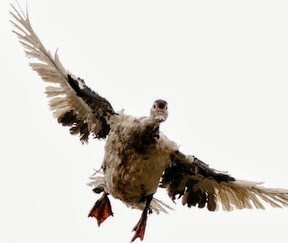 "Why do birds fly backward in a dust storm? To keep the sand out of their eyes.”
"Why do birds fly backward in a dust storm? To keep the sand out of their eyes.”Making a joke out of hardship, commonly called “gallows humor,” has been around a long time. The people struggling through the Dust Bowl were no different from anyone else. They also used humor as a way to cope. Here are a few jokes born out of the Dust Bowl.
“Did you hear about the farmer who went to the bank to get a loan. They turned him down when they saw his land blow past the window.”
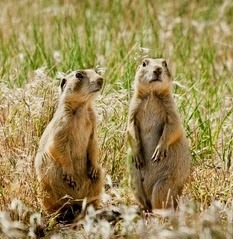 “During a long dust storm, the air was so thick with dust that the prairie dogs thought they had been buried. So, they dug UP through the dust to get out. Later, the dust storm settled, and for three hours it rained prairie dogs.”
“During a long dust storm, the air was so thick with dust that the prairie dogs thought they had been buried. So, they dug UP through the dust to get out. Later, the dust storm settled, and for three hours it rained prairie dogs.” "How did folks revive the farmer who fainted when a drop of rain hit his head? They pour a bucket of sand on his face.”
“In the middle of the dry years, it got so hot that hens were laying hard boiled eggs.”
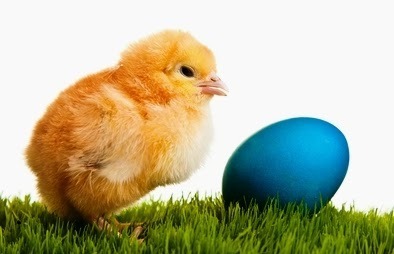 “I hope it rains before the kids grow up,” one farmer said, “They ain’t never seen any.”
“I hope it rains before the kids grow up,” one farmer said, “They ain’t never seen any.”Why is gallows humor funny, irresistible, irrepressible? Perhaps humor is a sign of resilience and sends a message that suffering has not diminished one’s sense of play. Or a sign of defiance and resistance because it shows that one’s wit and intelligence have survived. And it certainly fosters a sense of community, a shared suffering, and a connection. It helps people gain perspective on their struggles.
Sigmund Freud even had something to say about it. “The ego refuses to be distressed by the provocations of reality, to let itself be compelled to suffer. It insists that it cannot be affected by the traumas of the external world; it shows, in fact, that such traumas are no more than occasions for it to gain pleasure.”
Theorist Martin Armstrong, who wrote about the function of laughter in society, may have said it best when he wrote, “For a few moments, under the spell of laughter, the whole man is completely and gloriously alive: body, mind and soul vibrate in unison… the mind flings open its doors and windows… its foul and secret places are ventilated and sweetened.”
Oh, one more joke before I go. “Did you hear about the pilot who parachuted out of his plane in a dust storm? He had to shovel his way to the ground.”
Jokes courtesy of Wessels Living History Farm
Published on September 26, 2013 20:45
September 17, 2013
Home on the Range -- A telephone but no toilet
 Try to image what it was like to live on a prairie farm in the 1930s. What conveniences do you take for granted which would have been missing from a farm back then?I recently came across the following statistics from the 1930 census. Interestingly, many more farms had a telephone and a radio than had water piped into the house or electricity, other than the small amount they produced themselves with a wind generator.
Try to image what it was like to live on a prairie farm in the 1930s. What conveniences do you take for granted which would have been missing from a farm back then?I recently came across the following statistics from the 1930 census. Interestingly, many more farms had a telephone and a radio than had water piped into the house or electricity, other than the small amount they produced themselves with a wind generator.
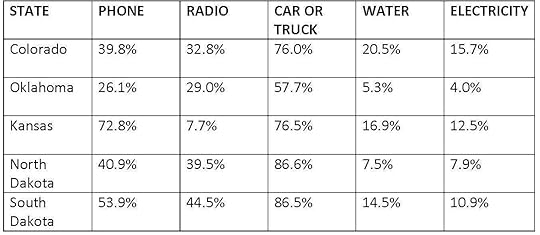 Imagine trying to stay clean with all that dust, but no shower, no running water at the sink, and no indoor toilet.
Imagine trying to stay clean with all that dust, but no shower, no running water at the sink, and no indoor toilet.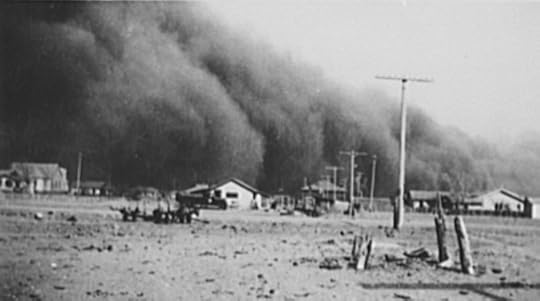
Published on September 17, 2013 10:20
Home of the Range-A telephone but no toilet
 Try to image what it was like to live on a prairie farm in the 1930s. What conveniences do you take for granted which would have been missing from a farm back then? I recently came across the following statistics from the 1930 census. Interestingly, many more farms had a telephone and a radio than had water piped into the house or electricity, other than the small amount they produced themselves with a wind generator.
Try to image what it was like to live on a prairie farm in the 1930s. What conveniences do you take for granted which would have been missing from a farm back then? I recently came across the following statistics from the 1930 census. Interestingly, many more farms had a telephone and a radio than had water piped into the house or electricity, other than the small amount they produced themselves with a wind generator.
 Imagine trying to stay clean with all that dust, but no shower, no running water at the sink, and no indoor toilet.
Imagine trying to stay clean with all that dust, but no shower, no running water at the sink, and no indoor toilet.
Published on September 17, 2013 10:20
September 8, 2013
Vona, Colorado Today…Ghost Town or Not?
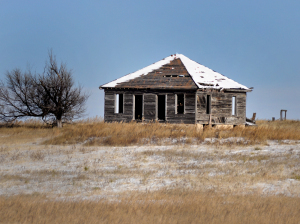 Photos by Diddley Squat
Photos by Diddley SquatIn researching Vona, Colorado, where the historical chapters of COYOTE WINDS take place, I came across Ghost towns--Vona, a site full of fabulous pictures of hundreds of abandoned (or nearly so) towns throughout the United States and Canada.
I was somewhat distressed to see that Vona is among them. The photos are courtesy of Diddley Squat.
Wikipedia puts the population of Vona at 106 people in 2010, so it’s not completely a ghost town. And there is an elementary school serving a school district of 510 square miles. Well, that is a lot of open space. And a lot of empty homes and buildings.
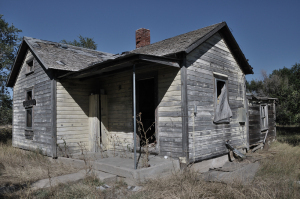
When my father was in his late 70s, he talked about going back to visit the town where he grew up, but he never did get around to it. I think he knew that his sweet memories of Vona might become too bittersweet if he saw a boarded up town.Take a look: VONA
Published on September 08, 2013 16:33
September 1, 2013
Announcing the Second Edition of COYOTE WINDS
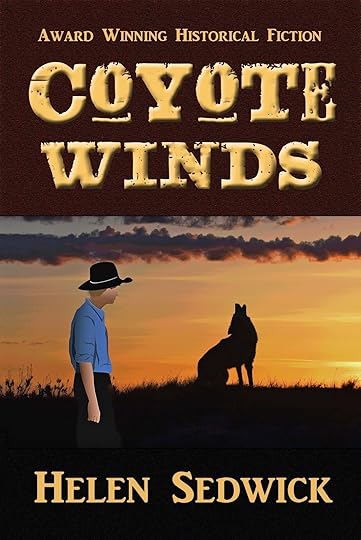 The new edition of COYOTE WINDS launched last week. It features a new cover and additional material.
The new edition of COYOTE WINDS launched last week. It features a new cover and additional material.Many readers have wanted to know more about Clare Vincent, the sister of the main character Myles. Throughout the book, Clare writes letters to friends, to Henry Ford and even to President Hoover. She writes and sells articles to Good Housekeeping and local papers. The new edition includes her letters and articles as an appendix.
Here is one of them.
Clare Grace VincentVona, ColoradoOctober 1, 1930Mr. Henry FordFord Motor CompanyDearborn, Michigan
Dear Mr. Ford,
My father has one of your gas-powered tractors. He says with your tractor he can plow 40 acres in 3 days. If he had to use a team of horses it would take weeks. I am wondering if you can make something like a tractor for my mother. We have no electricity, so my mother and I have to do everything by hand. Laundry, dishes, pumping water. Our stove uses coal, which makes a big mess, which we have to sweep up because we don’t have a vacuum cleaner.
The other day, while my mother and I were hanging laundry, I heard what I thought were the drums of a marching band. I asked myself, what is a marching band doing in the middle of Kit Carson County, Colorado? Well, I saw dark cloud coming our way and white hail stones bouncing off the ground. The cloud was still a quarter mile away, so I knew those hail stones were going to be egg-sized at least.
My mother and I shooed the chickens into the hen house and pulled the cows into the barn. Cows can be really stupid and stubborn, so it took a while. We hid in the woodshed when the hail hit. The woodshed has a tin roof, and it sounded like we were inside a kettle drum. I thought my head was going to explode.
When the storm moved on we went to check on the laundry. Every sheet and nearly stitch of clothing had been snapped off the line and was covered with mud. Some were torn up. I have never seen my mother look so tired, so I didn’t complain, which I am often accused of doing. We started all over again with the laundry.
Is there a way to make a gas-powered washing machine? If there is, please let me know how much it would cost. Thank you very much.
Sincerely,Clare Grace Vincent
Published on September 01, 2013 19:09
July 28, 2013
Mother fox
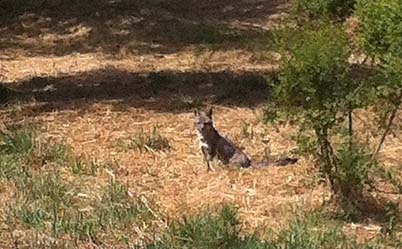 While the dog this morning, a beautiful grey fox kept a close eye on us. She didn't move, but she did bark at us. Foxes have a strange, rasping bark. And it's much louder than you would expect from such a small animal.
While the dog this morning, a beautiful grey fox kept a close eye on us. She didn't move, but she did bark at us. Foxes have a strange, rasping bark. And it's much louder than you would expect from such a small animal.I have seen three kits in this same area. This is probably Mom.
Published on July 28, 2013 16:25
July 24, 2013
Most People Fail Simple Environmental Awareness Test
The EPA has compiled a simple test of environmental literacy. See how you do. 1. There are many different types of animals and plants, and they live in many different types of environments. What word is used to describe this idea: multiplicity, biodiversity, socio-economics, or evolution? 2. Which of the following is a renewable resource: oil, iron ore, trees, or coal? 3. Which of the following household materials is considered hazardous waste: plastic packaging, glass, batteries, or spoiled food? 4. What is the most common major cause of pollution of streams, rivers and oceans? 5. Most electricity in the U.S. is generated from what source? 6. What is the primary environmental benefit of wetland areas? 7. Having ozone in the earth's upper atmosphere protects us from what? 8. What is the current solution to the disposal of most nuclear waste in the United States? 9. What is the largest source of carbon monoxide in the U.S.? 10. What is the most common reason animal species become extinct? 11. What is the name of the primary federal agency that works to protect the environment? 12. Where does most household garbage eventually end up once it leaves the home?
 Answers:1. Biodiversity 2. Trees 3. Batteries 4. Surface water running off yards, streets, paved lots and farm fields 5. By burning coal, oil and wood 6. To help purify water before it enters lakes, streams, rivers and oceans 7. Harmful, cancer-causing sunlight 8. Store and monitor the waste at the plant 9. Motor Vehicles 10. Loss of habitat 11. Environmental Protection Agency 12. Landfills
Answers:1. Biodiversity 2. Trees 3. Batteries 4. Surface water running off yards, streets, paved lots and farm fields 5. By burning coal, oil and wood 6. To help purify water before it enters lakes, streams, rivers and oceans 7. Harmful, cancer-causing sunlight 8. Store and monitor the waste at the plant 9. Motor Vehicles 10. Loss of habitat 11. Environmental Protection Agency 12. LandfillsIf you didn’t answer most of the questions correctly, you are not alone. In a 2001 study by The National Environmental Education and Training Foundation, fewer than 2/3’s of American adults answered half the questions correctly.
 More than 66% failed.
More than 66% failed.Yet, the same study found that 95% of the public supports environmental education.
Why is environmental education important?
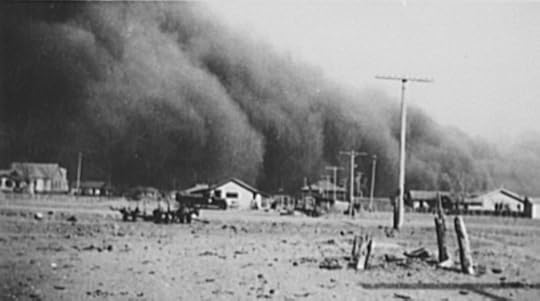 I suspect more damage has been done to the environment by ignorance than by malice. Not too long ago DDT, asbestos, chlorofluorocarbons, and lead paint were considered safe and useful. Slash and burn farming is still widely practiced. And remember the phrase, “the rain will follow the plow.” This 1881 slogan encouraged people to plow up vast sections of the semi-arid prairie. But rains did not follow the plow. Droughts occurred, as they always have and always will. And before long, the Dust Bowl was born.
I suspect more damage has been done to the environment by ignorance than by malice. Not too long ago DDT, asbestos, chlorofluorocarbons, and lead paint were considered safe and useful. Slash and burn farming is still widely practiced. And remember the phrase, “the rain will follow the plow.” This 1881 slogan encouraged people to plow up vast sections of the semi-arid prairie. But rains did not follow the plow. Droughts occurred, as they always have and always will. And before long, the Dust Bowl was born. We know better now. Or do we?
66% failed.
What we can learn from nature.
By studying nature, we learn its two patterns of organization are the web and the cycle, not domination by any one species, even man. Predator-prey cycles are a powerful example of what happens when one species dominates.
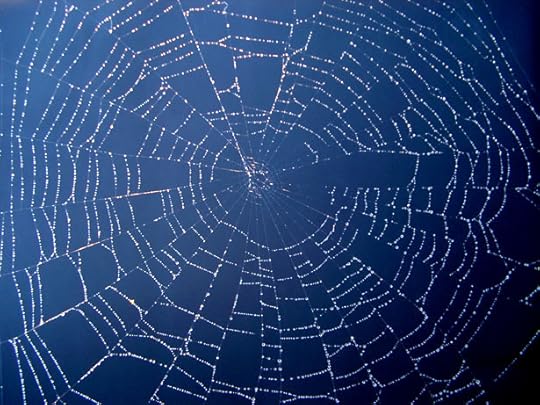 The study of living systems is the study of relationships, patterns, cause and effect. It tests assumptions and reveals unintended consequences. By increasing our environmental literacy, we come to appreciate the power of seemingly small variables such as rainfall, soil composition, wind currents, temperatures, migration patterns, advantageous and disadvantageous adaptations, and luck.
The study of living systems is the study of relationships, patterns, cause and effect. It tests assumptions and reveals unintended consequences. By increasing our environmental literacy, we come to appreciate the power of seemingly small variables such as rainfall, soil composition, wind currents, temperatures, migration patterns, advantageous and disadvantageous adaptations, and luck. And one of these variables is man whose disruptions of natural systems affect society in the form of erosion, floods, desertification, contamination, and disease.
Environmental literacy has been shown to be beneficial to both the students and the community. Since most environmental education involves hands-on experiences such as planting gardens, restoring waterways, and caring for injured wildlife, people are making a difference. The learning is deeper, more meaningful.
And studies have shown that as people gain environmental literacy they increasingly adopt pro-environmental behaviors such as energy conservation, recycling, and eco-conscious buying choices. They understand that even small actions make a difference to the web and cycles of our living systems.
Interested in knowing more? Many resources are on-line. For example:
http://www.ecoliteracy.org/ http://classroomearth.org/ http://education.nationalgeographic.com/education/program/environmental-literacy-guides/?ar_a=1 http://livinggreenmag.com/2013/02/27/energy-ecology/eco-classrooms-teaching-environmental-literacy-in-schools/
Environmental pressures will increase.
 Our children will face tougher environmental challenges than we do. Increasing population and political conflict will cause shortages of food and water. Climate change will impact agriculture and trade. Rising oceans will flood cities. Green and sustainable practices will be accused of harming our ability to compete in the global economy. Environmental educators will be accused of teaching children “junk” science. (For a tooth-jarring rant against environmental education, see http://www.redstate.com/dhorowitz3/2011/06/22/its-official-you-must-be-an-eco-socialist-to-graduate-in-maryland/). The problems will be complex, and the solutions will involve tradeoffs, conflict, and compromise.
Our children will face tougher environmental challenges than we do. Increasing population and political conflict will cause shortages of food and water. Climate change will impact agriculture and trade. Rising oceans will flood cities. Green and sustainable practices will be accused of harming our ability to compete in the global economy. Environmental educators will be accused of teaching children “junk” science. (For a tooth-jarring rant against environmental education, see http://www.redstate.com/dhorowitz3/2011/06/22/its-official-you-must-be-an-eco-socialist-to-graduate-in-maryland/). The problems will be complex, and the solutions will involve tradeoffs, conflict, and compromise. Our children are going to inherit the environmental mess of prior generations. Let’s give them some tools for dealing with it, starting with environmental literacy.
Published on July 24, 2013 16:27
July 8, 2013
Great Review in Publishers Weekly Select
At long last, a review in Publishers Weekly. They liked COYOTE WINDS. I sigh with relief with every nice review. After all the rejections I received from agents, these reviews are a welcome treat.
Link to Publishers Weekly Review of COYOTE WINDS
Coyote Winds Helen Sedwick. Ten Gallon Press (www.tengallonpress.com), $9.99 paper (244p) ISBN 978-0-615-69261-6 "Out in the grass, a coyote pup ran in circles. All around him, he sensed fear. It wasn't snow, for the day was hot. It wasn't rain, for his tongue was dry. It wasn't darkness, for the sun glowed as red as blood." With this understated description, Sedwick lays the groundwork for an absorbing novel. In the western prairie circa 1930, 13-year-old Myles brings a coyote pup home in an attempt to tame it and keep it as a pet. Taming the untamable quickly becomes a theme as his father struggles to fight the growing drought that is wreaking havoc with his crops. Sedwick's prose is simple, but possesses an underlying beauty that captures the world in which her story takes place. The narrative soon shifts to the 21st century, as Myles's grandson Andy struggles to find a way to keep his grandfather's stories of the prairie alive. While Sedwick's novel is geared toward teenagers, it should also appeal to adults, particularly those interested in recent American history. Ages 12–up. Reviewed on: 07/08/2013
Link to Publishers Weekly Review of COYOTE WINDS
Coyote Winds Helen Sedwick. Ten Gallon Press (www.tengallonpress.com), $9.99 paper (244p) ISBN 978-0-615-69261-6 "Out in the grass, a coyote pup ran in circles. All around him, he sensed fear. It wasn't snow, for the day was hot. It wasn't rain, for his tongue was dry. It wasn't darkness, for the sun glowed as red as blood." With this understated description, Sedwick lays the groundwork for an absorbing novel. In the western prairie circa 1930, 13-year-old Myles brings a coyote pup home in an attempt to tame it and keep it as a pet. Taming the untamable quickly becomes a theme as his father struggles to fight the growing drought that is wreaking havoc with his crops. Sedwick's prose is simple, but possesses an underlying beauty that captures the world in which her story takes place. The narrative soon shifts to the 21st century, as Myles's grandson Andy struggles to find a way to keep his grandfather's stories of the prairie alive. While Sedwick's novel is geared toward teenagers, it should also appeal to adults, particularly those interested in recent American history. Ages 12–up. Reviewed on: 07/08/2013
Published on July 08, 2013 16:38
July 1, 2013
Coyote Winds Giveaway
 Don't miss out.
Don't miss out.On Goodreads, you can enter to win one of five autographed copies of COYOTE WINDS.
Click here: Coyote Winds Giveaway on Goodreads
Published on July 01, 2013 16:19



